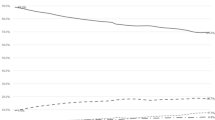Abstract
The testing of economic theories of fertility has been hampered by the absence of suitable data on the direct (versus opportunity) costs of children. This study hopes to help remedy this deficiency, first, by proposing a new method of estimating the magnitude of money expenditures parents make on their children. This method is then applied to the urban sample of the 1960–1961 U.S. Consumer Expenditure Survey to estimate the total money expenditure costs of children to age eighteen. The distribution of these costs by income level, by birth order, by age of the child, and by components of cost (food, housing, clothing, and so on) is considered. The impact of the number and age of children on family living standards is also explored.
Similar content being viewed by others
References
Allen, R. G. D. and Bowley, A. L.: 1935, Family Expenditure, Staples, London.
Becker, Gary S.: 1960, ‘An Economic Analysis of Fertility’, in National Bureau of Economic Research, Demographic and Economic Change in Developed Countries, Princeton Univ. Press, Princeton, pp. 209–231.
Blake, Judith: 1968, ‘Are Babies Consumer Durables?’, Population Studies 22, 5–25.
Brown, Alan and Deaton, Angus: 1972, ‘Models of Consumer Behavior: A Survey’, Economic Journal 82, 1145–1236.
Cain, Glen G.: 1971, ‘Issues in the Economics of a Population Policy for the United States’, Discussion Paper No. 88, Institute for Research on Poverty, Univ. of Wisconsin.
Cain, Clen G. and Weininger, Adriana: 1973, ‘Economic Determinants of Fertility: Results from Cross-Sectional Aggregate Data’, Demography 10, 205–223.
Council of Economic Advisors: 1964, Annual Report to the President.
DeTray, Dennis N.: 1973, ‘Child Quality and the Demand for Children’, Journal of Political Economy 81, Part II: S70-S95.
Easterlin, Richard A.: 1969, ‘Towards a Socioeconomic Theory of Fertility: A Survey of Recent Research on Economic Factors in American Fertility’, in S. J.Behrman, LeslieCorsaJr., and RonaldFreedman (eds.), Fertility and Family Planning: A World View, The University of Michigan Press, Ann Arbor, pp. 127–156.
Easterlin, Richard A.: 1971, ‘Does Human Fertility Adjust to the Environment?’, American Economic Review 61, 399–407.
Easterlin, Richard A.: 1972, ‘The Economics and Sociology of Fertility: A Synthesis’, prepared for the Seminar on Early Industrialization, Shifts in Fertility, and Changes in Family Structure, Institute for Advanced Study, Princeton, New Jersey, June 18–July 9.
Espenshade, Thomas J.: 1972a, ‘The Cost of Children in Urban United States’, unpublished Ph.D. dissertation, Princeton.
Espenshade, Thomas J.: 1972b, ‘The Price of Children and Socio-Economic Theories of Fertility’, Population Studies 26, 207–221.
‘Estimating Equivalent Incomes or Budget Costs by Family Type’, 1960, Monthly Labor Review 83, 1197–1200.
Henderson, A. M.: 1949–1950, ‘The Cost of Children’, Part I in Population Studies 3, 130–150; Parts II and III in Population Studies 4, 267–298.
Indian Institute of Public Opinion: 1964, ‘The Investment in Youth till the Age of Majority’, Quarterly Economic Report 9, 15–28.
Jorgensen, Erling: 1965, Income-Expenditure Relations of Danish Wage and Salary Earners, Copenhagen.
Kmenta, Jan: 1971, Elements of Econometrics, The Macmillan Company, New York.
Liviatan, Nissan: 1964, Consumption Pattern in Israel, Falk Project for Economic Research in Israel, Jerusalem.
Mincer, Jacob: 1963, ‘Market Prices, Opportunity Costs, and Income Effects’, in Carl F.Christ, et al. (eds.), Measurement in Economics: Studies in Mathematical and Econometrics in Memory of Yehuda Grunfeld, Stanford University Press, Stanford pp. 67–82.
Nicholson, J. L.: 1949, ‘Variations in Working Class Family Expenditure’, Journal of the Royal Statistical Society CXII, 359–411.
Okun, Bernard: 1958, ‘A Rational Economic Model Approach to the Birth Rate’, Rand Corporation, P-1458, August 12.
Orshansky, Mollie: 1965, ‘Counting the Poor: Another Look at the Poverty Profile’, Social Security Bulletin 28, 3–29.
Orshansky, Mollie: 1969, ‘How Poverty is Measured’, Monthly Labor Review 92, 37–41.
Prais, S. J. and Houthakker, H. S.: 1971, The Analysis of Family Budgets, Monograph No. 4 (reprinted), Dept. of Applied Economics, Univ. of Cambridge.
Preston, Samuel H.: 1971, ‘Marital Fertility and Female Employment Opportunity’, Paper delivered at the Population Association of America Meetings, Washington, D.C.
Robinson, Warren c. and Horlacher, David E.: 1971, ‘Population Growth and Economic Welfare’, Reports on Population/Family Planning, February, 1971, No. 6.
Schultz, T. Paul:, 1969, ‘An Economic Model of Family Planning and Fertility’, Journal of Political Economy 77, 153–180.
Schultz, Theodore W. (ed.): 1973, ‘New Economic Approaches to Fertility’, Journal of Political Economy 81 (2), Part II.
Sydenstricker, Edgar and King, Wilford I.: 1920, ‘A Method of Classifying Families According to Incomes in Studies of Disease Prevalence’, U.S. Treasury Dept, Public Health Reports 35, pp. 2829–2846.
Tabbarah, Riad B.: 1971, ‘Household Decision-Making Regarding Desired Family Size’, Unpublished Paper, International Population and Urban Research, Univ. of California, Berkeley.
U. S. Bureau of the Census: 1966, U.S. Census of Population: 1960. Subject Reports. Age at First Marriage. Final Report PC(2)-4D.
U. S. Bureau of the Census: 1968, U.S. Census of Population: 1960. Subject Reports. Childspacing. Final Report PC(2)-3B.
U.S. Bureau of Labor Statistics: 1948, Workers' Budgets in the United States: City Families and Single Persons, 1946 and 1947, BLS Bulletin 927.
U.S. Bureau of Labor Statistics: 1964, ‘Survey of Consumer Expenditures’, 1960–61, Supplement 3-Part A to BLS Report 237–38, July, 1964.
Willis, Robert J.: 1973, ‘A New Approach to the Economic Theory of Fertility Behavior’, Journal of Political Economy 81, S14-S64.
Author information
Authors and Affiliations
Additional information
This research was supported by a grant to International Population and Urban Research, University of California, Berkeley, from the National Institute of Child Health and Human Development (5 R01 HD04602-03). The author wishes to thank Warren C. Robinson for his constructive comments on an earlier version of this paper.
Rights and permissions
About this article
Cite this article
Espenshade, T.J. Estimating the cost of children and some results from urban United States. Soc Indic Res 1, 359–381 (1974). https://doi.org/10.1007/BF00303863
Received:
Issue Date:
DOI: https://doi.org/10.1007/BF00303863




